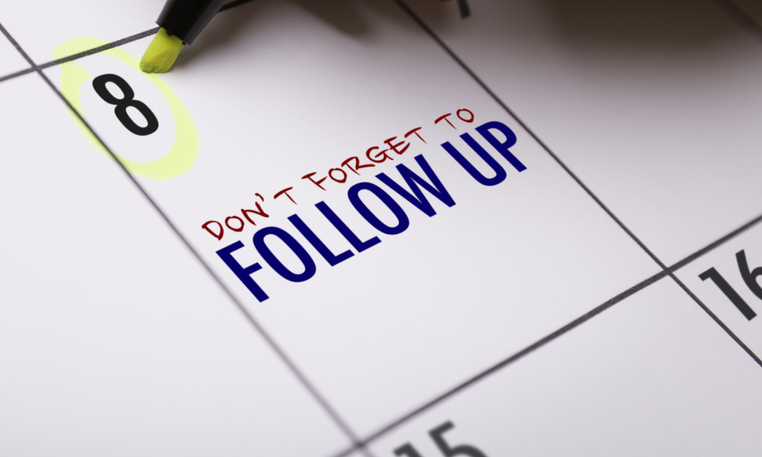Reaching out to your print buyers via email is essential to growing your business.
But here’s the thing: sending out an email and sitting back, hoping for business to flood in, just won’t cut it. Love it or hate it, post-email follow-up is essential to ensure your marketing efforts bear fruit.
9 Considerations for Follow-Up When Sending Emails to Your Print Buyers
1. Patience is a Virtue
First things first, patience is vital.
While it’s tempting to expect an immediate response after hitting the send button, the reality is that it often takes time for print buyers to act on your email.
Takeaway: Give them some breathing room, and don’t rush the follow-up process.
2. Timing is Everything
When you do decide to follow up, timing is crucial.
Sending a follow-up email too soon can come across as pushy, while waiting too long might make your print buyers forget about your initial message.
Takeaway: Aim to follow up within a week or so, striking that perfect balance.
3. Personalization is Your Superpower
Nothing catches attention like a personalized message.
Instead of sending a generic follow-up email, mention specifics from your previous communication, such as a project you discussed or a shared interest.
Takeaway: Personalized messages make your follow-ups more memorable.

4. Email Analytics Unveiled
Taking advantage of data-driven insights that you can only get by diving into the nitty-gritty of email analytics is important.
The following insights can help you refine your follow-up strategy:
Open Rates: Monitor how many print buyers opened your email. Low open rates may indicate a need for a more compelling subject line or sender name. (Pro tip: For any email address that opened your email five or more times, reach out by phone for additional follow-up.)
Click-Through Rates (CTR): Track how many people clicked on links within your email. Low CTRs suggest that your content or call-to-action may need improvement. (Pro tip: If they clicked through, don’t forget the power of a follow-up phone call. “We recently sent out an email regarding XYZ. I’m just calling to see if we can help you in this way or if you have any questions we can answer.”)
Conversion Rates: This is the holy grail. It shows how many recipients took the desired action, such as requesting a quote or placing an order. Analyze this to understand the effectiveness of your email.
Bounce Rates: Bounced emails are those that couldn’t be delivered. A high bounce rate might indicate issues with your email list quality.
Unsubscribes: Keep an eye on the number of people who unsubscribe after your email. This can be a sign that your content isn’t resonating with your audience.
Email Client Data: Understanding which email clients your recipients use (e.g., Gmail, Outlook) can help you optimize your emails for better compatibility.
Takeaway: You can’t refine what you don’t know. As Maya Angelou says, “Do the best you can until you know better. Then when you know better, do better.”
5. A/B Testing for Improvement
Don’t be afraid to experiment.

A/B testing involves sending two versions of an email to a small sample of your list and determining which performs better. Test different subject lines, content, or even sending times to optimize your follow-up emails.
Takeaway: Practice makes perfect to help you know what resonates with your audience and will give you the best results.
6. The Power of Automation
Consider using email automation tools to schedule and manage your follow-ups efficiently.
These tools can send personalized messages based on recipient behavior, making your follow-up process more streamlined and effective.
Takeaway: Automation doesn’t remove the personal touch. It frees you up to give you more time to be personal with your client base.
7. Persistence Pays Off
Remember that a single follow-up might not be enough.
It’s often necessary to follow up multiple times to get a response. Be persistent but respectful, and know when to gracefully move on if a prospect isn’t interested.
Takeaway: Don’t underestimate the power of follow-up on an email campaign with a direct mail postcard or a phone call.

8. Offer Incentives and Special Deals
Sometimes, a little extra incentive can go a long way in encouraging your print buyers to take action.
Consider offering exclusive discounts, promotional offers, or special deals in your follow-up emails. This can create a sense of urgency and make recipients more likely to engage with your print services.
Takeaway: Clearly communicate the value of incentives to make your follow-up even more compelling.
Email Marketing For Printers
Sending marketing emails is just the first step in winning over print buyers.
Following up is where the magic happens.
By being patient, personalizing your messages, leveraging email analytics, and using the power of automation, you’ll be well on your way to turning those leads into loyal customers.
Looking for an email marketing solution designed exclusively for printers? Check out Email Marketing For Printers.


